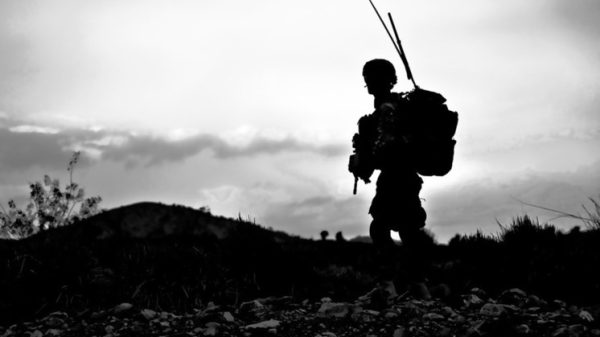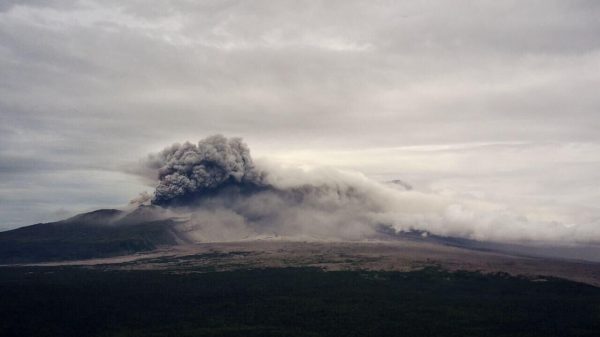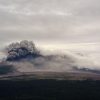
Perseverance seen from its rocket cradle just before landing
Credit: REUTERS
Nasa’s Mars Perseverance rover has sent back its first colour images from the surface of the Red Planet.
The space agency also released a dramatic image of the Mars Perseverance rover being lowered onto the surface during its landing on Thursday.
The image (below), unveiled during a press briefing on Friday, was taken by the descent stage that placed the vehicle on the ground.
Adam Steltzner, Mars 2020 chief engineer, told the briefing he hoped the image of the rover landing would become as iconic as the picture of Buzz Aldrin on the moon in 1969, the image of Saturn seen from Voyager 1 or the Pillars of Creation taken by the Hubble Telescope.

The rover's first colour image from the surface of Mars
Credit: REUTERS
He added: "We can only hope in our efforts to engineer spacecraft and explore our solar system that we might be able to some day contribute yet another iconic image to this collection.
"I am happy to say that I am hopeful that today we can with this.
"This is an image of the rover Perseverance slung beneath the descent stage, its propulsion pack, as it is being lowered to the surface of Mars.

The Mars Reconnaissance Orbiter captured a photograph of the rover descending via parachute
Credit: REUTERS
"You can see the dust kicked up by the rover’s engines, we are probably about two metres or so above the surface of Mars.
"You can see the mechanical bridles that hold the rover underneath the descent stage — that’s three straight lines heading down to the top deck — and then the curly electrical umbilical that is taking all of the electrical signals from the descent stage down to the computer inside the belly of the rover."
Read more: Why Nasa’s Mars landing means humans could follow in the 2030s
The team also showed two colour pictures the rover had taken after landing safely on Mars.
The first high-resolution colour image to be sent back was taken from the rover’s front hazard camera and shows a barren and dusty landscape and the shadow of the rover across the ground.

Yellow-ish rocks beneath the rover's front wheel
Credit: REUTERS
Speaking at the briefing, Hallie Gengl, instrument data systems operation lead for the space agency’s Multimission Image-Processing Laboratory, said: "This is our first colour front haz-cam [hazard camera] image and our first colour image from the surface of Mars."
Another image (below) was of the ground beneath the rover’s front-right wheel and appeared to show yellow rocks while another from the Mars Reconnaissance Orbiter showed the rover sailing into Mars’ Jezero Crater — a 28-mile-wide depression containing sediments of an ancient river delta — with its parachute trailing behind.
After the rover, which blasted off from Earth last July, entered the Martian atmosphere there were "seven minutes of terror" as it made its way to the surface.
It took more than 11 minutes for news of the safe landing to reach Earth, arriving at just before 9pm (GMT) on Thursday.
The rover — a scientific laboratory the size of a car — is on a mission to search for signs of ancient life and explore and collect samples for future return to Earth from diverse environments on Mars.
Perseverance will spend the coming years scouring for signs of ancient microbial life in a mission that will bring back samples from Mars to Earth and prepare the way for future human visitors.
NASA’s Perseverance rover mission to Mars (Part 04)
Scientists know that 3.5 billion years ago Jezero was the site of a large lake, complete with its own delta.
They believe that while the water may be long gone, somewhere within the crater, or maybe along its 2,000-foot-tall (610 metre) rim, evidence that life once existed there could be waiting.
Perseverance will gather rock and soil samples using its drill and will store the sample cores in tubes on the Martian surface ready for a return mission to bring around 30 samples to Earth in the early 2030s.
Pictured: Mars landing and subsequent photos
It will also trial technologies to help astronauts make future expeditions to Mars.
These include testing a method for producing oxygen from the Martian atmosphere, identifying other resources such as subsurface water, and improving landing techniques.
They also involve characterising weather and other environmental conditions that could affect future astronauts living and working on Mars.
























































Свежие комментарии